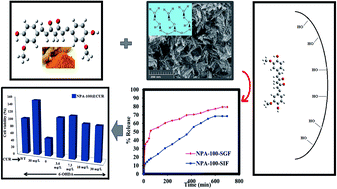Synthesis of nanostructured alumina with ultrahigh pore volume for pH-dependent release of curcumin
Abstract
In a new approach, a series of nanoporous non-crystalline alumina (NPA) materials was designed and developed by an evaporation-induced self-assembly method in the presence of various weight percentages of tetrabutylammonium bromide (Bu4N+Br−) versus P123 (0, 24, 30, 56 and 100) as the dual structure-directing agents. The effect of different amounts of Bu4N+Br− on the morphology, pore sizes, and surface area of the samples was carefully monitored. The samples were characterized by N2 adsorption–desorption isotherms, X-ray diffraction (XRD), Fourier transform infrared spectroscopy (FT-IR), field emission scanning electron microscopy (FE-SEM), transmission electron microscopy (TEM) and zeta potential instrumentational methods. The obtained samples have relatively high surface areas (up to 415 m2 g−1), great pore volumes (up to 2.00 cm3 g−1) and large pore sizes (up to 23.0 nm). The results indicated that higher pore volume (2.00 cm3 g−1) was obtained when only tetrabutylammonium bromide (namely NPA-100) was used than when only P123 namely NPA-0 (0.5 cm3 g−1) was used as a template. These new supports were used, for the first time, as an inorganic host for poorly soluble guest of curcumin (CUR). XRD analysis confirmed the amorphous state of CUR after being loaded into the NPAs, which is indicative of the full dispersion of the drug into the pores. The in vitro release behavior of these compounds was studied in simulated gastric fluid (SGF, pH = 1.2) and simulated intestinal fluid (SIF, pH = 6.8). The result indicated that the release of insoluble curcumin reached 80% in SGF when it was supported on alumina with ultrahigh pore volume. Moreover, this carrier showed high drug adsorption. The potential of the NPA-100@CUR in protecting SH-SY5Y cells from oxidative stress by toxin 6-OHDA that caused parkinsonian was tested. The results indicated that the formulation neutralizes 6-OHDA toxicity and significantly enhances cell survival.



 Please wait while we load your content...
Please wait while we load your content...